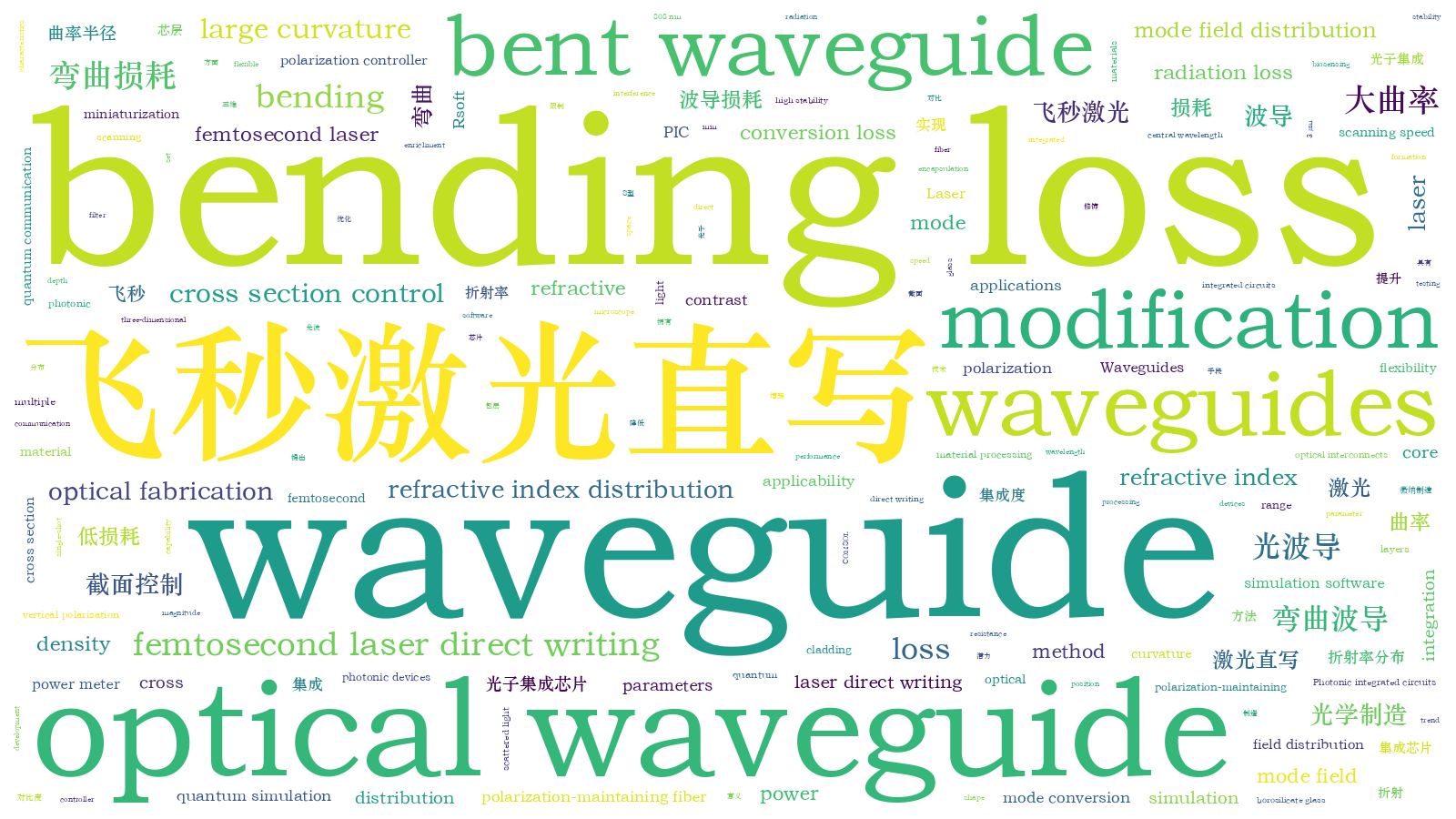大曲率低损耗弯曲波导的飞秒激光直写【增强内容出版】
Femtosecond laser direct writing (FLDW) has been widely used in material processing to improve material performance due to its high flexibility, true three-dimensional capability, and wide applicability to various materials. Photonic integrated circuits (PICs) constructed by FLDW are advantageous in terms of high stability and strong resistance to interference, making them suitable for applications in optical interconnects, biosensing, quantum communication, and quantum simulation. With the continuous expansion and enrichment of these applications, miniaturization of photonic devices has become an inevitable trend. However, the integration density of PICs is significantly limited by the loss caused by large curvature waveguides (including 90°bending, 180° bending, and S-shaped bending) due to the low refractive index contrast of waveguides produced by single-shot FLDW. Although various methods have been reported to optimize the bending loss of large curvature waveguides, none of them can simultaneously meet the requirements of high integration density and wide applicability range. In this work, we employ a method of multiple laser modifications to enhance the refractive index contrast between the core and cladding of waveguides, optimize the cross-sectional refractive index distribution of the core, and achieve a bending loss as low as 0.64 dB/cm for S-shaped bent waveguides with a radius of 20 mm. Since the modification lines are written inside the waveguide and completely consistent with the bending shape and formation of the waveguide, this method possesses the characteristics of high integration density and wide applicability range, providing an important basis for the miniaturization of PICs.
This paper analyzes the causes of bending loss in waveguides and proposes a method of multiple laser modifications to enhance the refractive index contrast between the core and cladding of waveguides, optimizing the cross-sectional refractive index distribution of the core. Then, the mode field distribution within the bent waveguide and the bending loss of the bent waveguide before and after modification are simulated using professional optical waveguide simulation software, COMSOL and Rsoft, respectively. Finally, S-shaped bent waveguides and modification lines are written in alkaline-earth borosilicate glass using a 1030 nm femtosecond laser. By adjusting the scanning order, center spacing, writing power, angle, density, writing mode, and number of layers of both the waveguide and the modification lines, the mode conversion loss between the straight waveguide and the bent waveguide is effectively reduced, as well as the radiation loss of the bent waveguide. In addition, the central wavelength of the testing laser is set to 808 nm. After adjusting the laser to vertical polarization using a polarization controller, the laser is coupled into the waveguide through a polarization-maintaining fiber. The output light is received by a power meter after removing the scattered light using an iris filter.
In the simulation part, the bending loss of the modified bent waveguide is significantly reduced compared with the unmodified bent waveguide, as demonstrated by the comparison of bending losses before and after modification using Rsoft simulations (Fig.3). The waveguide parameters remain unchanged during the simulations. In the experimental section, cross-sectional microscope images of the bent waveguide before and after modification are compared (Fig.4), and it is observed that the dimensions of the two waveguides are similar, indicating that the added modification lines do not occupy any additional space outside the waveguide. In addition, we provide experimental and simulated mode field distributions before and after adding modification lines, and observe that after adding modification lines, the mode field of the bent waveguide is to some extent closer to the center of the waveguide. Subsequently, different writing orders for the modification lines and the waveguide are designed (Fig.5), and the minimum bending loss is achieved with the optimal writing order. Furthermore, considering the flexibility in writing the modification lines, experimental investigations are conducted on the center spacing between the modification lines and the waveguide, as well as the power of the modification lines (Fig.6), the density and angle of the modification lines (Fig.7), and the number of layers and writing mode of the modification lines (Fig.8). These parameters could alter the refractive index distribution of the bent waveguide cross section, thereby influencing the magnitude of bending loss. Therefore, by selecting appropriate parameter combinations, the bending loss can be minimized.
In this study, we employ a method of inscribing modification lines inside bent waveguides using femtosecond laser to reduce the bending loss. The power of 380 mW, the scanning speed of 40 mm/s, and the depth of 190 μm are selected as writing parameters of the waveguide. Experimental results demonstrate that at a position of 20 mm, utilizing the optimal writing order and the side-writing approach, along with the innermost modification lines positioned at a center spacing of 0.3 μm from the waveguide, a power of 300 mW, an encapsulation angle of 10°, a density of 10°, and a layer number of 2, the bending loss of the S-shaped bent waveguide could be reduced to 0.64 dB/cm. These experimental findings are consistent with the Rsoft simulation results. This method offers a more convenient and flexible option for integration in photonic chips, contributing to further improvements and advancements in their development and applications.
李义春, 肖凯恒, 李中天, 刘畅, 于颜豪, 田振男. 大曲率低损耗弯曲波导的飞秒激光直写[J]. 中国激光, 2024, 51(16): 1602403. Yichun Li, Kaiheng Xiao, Zhongtian Li, Chang Liu, Yanhao Yu, Zhennan Tian. Femtosecond Laser Direct Writing of Bent Waveguides with High Curvature and Low Loss[J]. Chinese Journal of Lasers, 2024, 51(16): 1602403.






